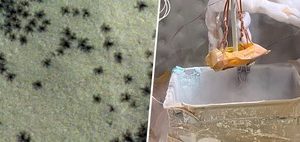Tests continue to validate the proper functioning of NASA’s VIPER (Volatiles Investigating Polar Exploration Rover) robot and preparations to send it to the surface of the Moon, where its mission will be to search for water. This mission has raised many expectations and is expected to mark the beginning of a stage of much greater presence of the US space agency on the Moon.
The most recent round of tests that the VIPER has been subjected to is reminiscent of an obstacle course, with large potholes comparable to lunar craters, boulders to climb over, and sandbanks as dangerous as one on Mars in which the Spirit robot was trapped forever.
These tests are the most realistic to date of VIPER’s ability to navigate the most difficult terrain during its mission to the South Pole of the Moon.
Engineers tested VIPER’s latest mobility engineering test unit, known as MGRU3 (Moon Gravitation Representative Unit 3) at NASA’s Glenn Research Center’s Simulated Lunar Operations Laboratory (SLOPE). in the US city of Cleveland. The MGRU3 features specially designed motor controllers for the lunar rover. These controllers are an essential part of the rover’s mobility system, controlling the motors that send power to the rover’s four wheels.
The VIPER crossing a very treacherous sandbank, with its wheels deeply sunk into the sand. Moving them like caterpillar legs, he managed to move forward. (Photo: NASA)
Unlike most car engines, which use a throttle and brake to speed up and slow down all four wheels, VIPER’s motor controllers make the rover’s wheels spin at whatever speed and force those in charge want. of the robot, with extreme precision to allow for better performance, explains Arno Rogg, a rover systems engineer at NASA’s Ames Research Center in California’s Silicon Valley. “These tests allowed us to verify the performance of the rover’s mobility system and to know that it will work well on the Moon.”
The tests have also helped engineers determine how well the rover will withstand the harsh conditions on the lunar surface.
The VIPER technical team wanted to see if the rover is capable of moving forward on loose terrain, where it sinks noticeably, or how much additional energy the robot will use depending on the type of obstacles or other difficulties encountered in a land.
Using the latest version of the vehicle’s software, engineers also tested the prototype’s ability to move its wheels in a special, coordinated way, much like a caterpillar moving its legs, which helps the vehicle get unstuck when stuck in the dirt. sand. The rover prototype also demonstrated its ability to decide on its own to stop when approaching a steep incline or in other dangerous situations. (Font: NCYT by Amazings)











![[Img #66751]](https://thelatestnews.world/wp-content/uploads/2022/08/They-test-the-off-road-capacity-of-the-VIPER-robotic-rover.jpg)



Add Comment